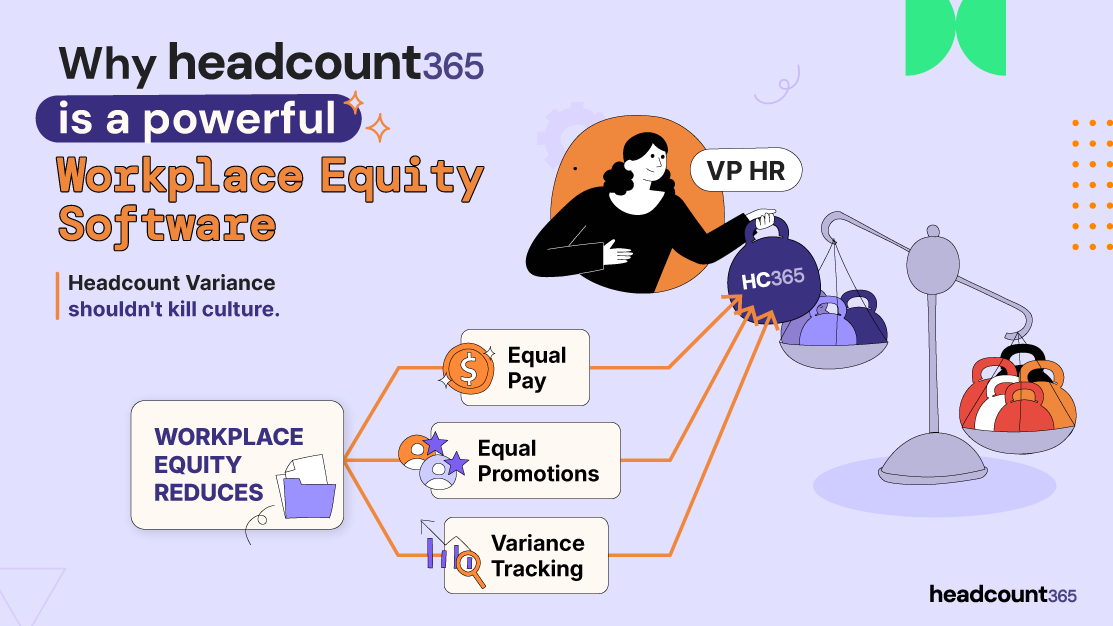Workplace Equity Data Reduces Risk & Improves Culture
Table of Contents
Workplace equity refers to fair treatment, access, opportunity, and advancement for all employees, and it begins on the headcount plan, where companies decide level, budget, and title of new hires. It continues through their tenure as an employee measured in 4 ways.
Compensation equity: Ensuring pay is fair and consistent for similar roles, regardless of gender, race, or background.
Opportunity equity: Providing equal access to promotions, training, and leadership roles.
Process equity: Making hiring, evaluation, and disciplinary processes unbiased and transparent.
Support equity: Offering accommodations or support that account for different personal or systemic challenges (e.g., flexible schedules, parental leave, disability access)
Workplace equity goes beyond equality (where everyone is treated the same) and instead focuses on fairness, which traditionally has meant adjusting policies or resources to account for different needs or starting points. But what if you could stop the variance at the root, by reducing the variance in every employees starting point upon entry? This is what headcount365 is about.
Identifying the Workplace Equity Problem
One of the biggest reasons I created headcount365, was my experience with the Covington Investigation & Report during my time at Uber. Among many takeaways we’re glaringly obvious data points from the HR & Recruiting systems about inequity lost in spreadsheets. An easy example?
Compensation exceptions were made during an offer negotiation.
How many times did we go above the compensation band? By what percentage? For whom? There was not a process to track when variance was happening, or by how much. Even worse, it was not tied to the EEOC information associated with the HR record.
When one group of people are systemically paid more than another at other companies, that will continue through to your company in the offer negotiation. If you’re not tracking changes to compensation banding from offer exceptions you’re creating variance in the starting points between employees with the same title or level.
Workplace Equity bad habits that continue the problem.
Promotions don’t fix the problem
A common way to get to compensation parity if you’ve overpaid someone at a lower level is to find a promotion. This is much easier than having the difficult conversation of reducing pay or re-leveling a role. While this band-aids the compensation variance, it does give the same opportunity to every person in the role for that promotion.
Poor headcount variance target tracking
Even in the most sophisticated companies, HR teams do not have access to how hiring variance impacts the future workplace equity data. Spreadsheets are the source of truth for headcount, but can vary greatly between finance and the executive team. Without a controllable approval process, managers can push recruiters or HRBPs for compensation exceptions to “get someone in the door”
Getting a clear picture meant hours of manual data collection with spreadsheets, surveys, and siloed systems, using and duct-taped dashboards—or worse, investing in expensive point solutions that still left gaps.
Headcount365 changes that. With no extra software to buy and no manual lift, HR teams get real-time access to the equity insights they need—built directly from their HRIS and recruiting data.
3 Ways Headcount365 Drives Workplace Equity
1. Progression Tracking
A top indicator of success is whether or a promotion was given for their previous work. As companies promote, it’s important to track key information like promotion frequency, promotion speed, and promotion consistency. Headcount365 helps leaders you can compare this to data from a connects to your HRIS and visualizes how employees move through the organization—by level, department, manager, or demographic. Spot where mobility slows, where it accelerates, and who gets left behind. No more guesswork on whether advancement is equitable—you'll see it clearly.
2. Hiring Variance Analysis
Workplace Equity issues start at the hiring process. Here are some key variances (among others) that headcount365 tracks to ensure you reduce the variance in workplace equity starting points.
Requisition Variance (Title, Level, Salary) - WHAT is changing? How many times does a workplace equity metric change from the original plan crafted by HRBP & Finance?
Variance Timing - WHEN do these changes happen? Is it planned, or a frantic exception to be made at the offer to get that perfect candidate in the door?
Variance Accountability - WHO is making these changes and why?
Approval Tracking - Compliant with SOX standards, access to make these approvals is automatically tracked.
Headcount365 helps you analyze where and how title, level, or compensation variance creeps in—by manager, department, or seniority. These insights help Talent Acquisition and HR Business Partners course-correct before disparities take root.
3. HR Risk Reporting
headcount365 has the only proactive risk detection platform, helping HR leaders proactively identify the changes that create workplace inequity. One dashboard shows all headcount and compensation data—across offers, current employees, and historical changes—so you can easily flag outliers, patterns, or inconsistencies. Whether you're conducting pay equity audits or setting comp bands, the data is always ready.
headcount365 Adds Critical Data Points to the Workplace Equity Conversation
The “old way”relied on disconnected spreadsheets and partial answers. Equity analysis was manual, incomplete, and often too late to change outcomes. Headcount365 gives you the full picture—automatically, in context, and in real time. It's the new way to reduce cultural risk and build a more equitable organization from the inside out.

